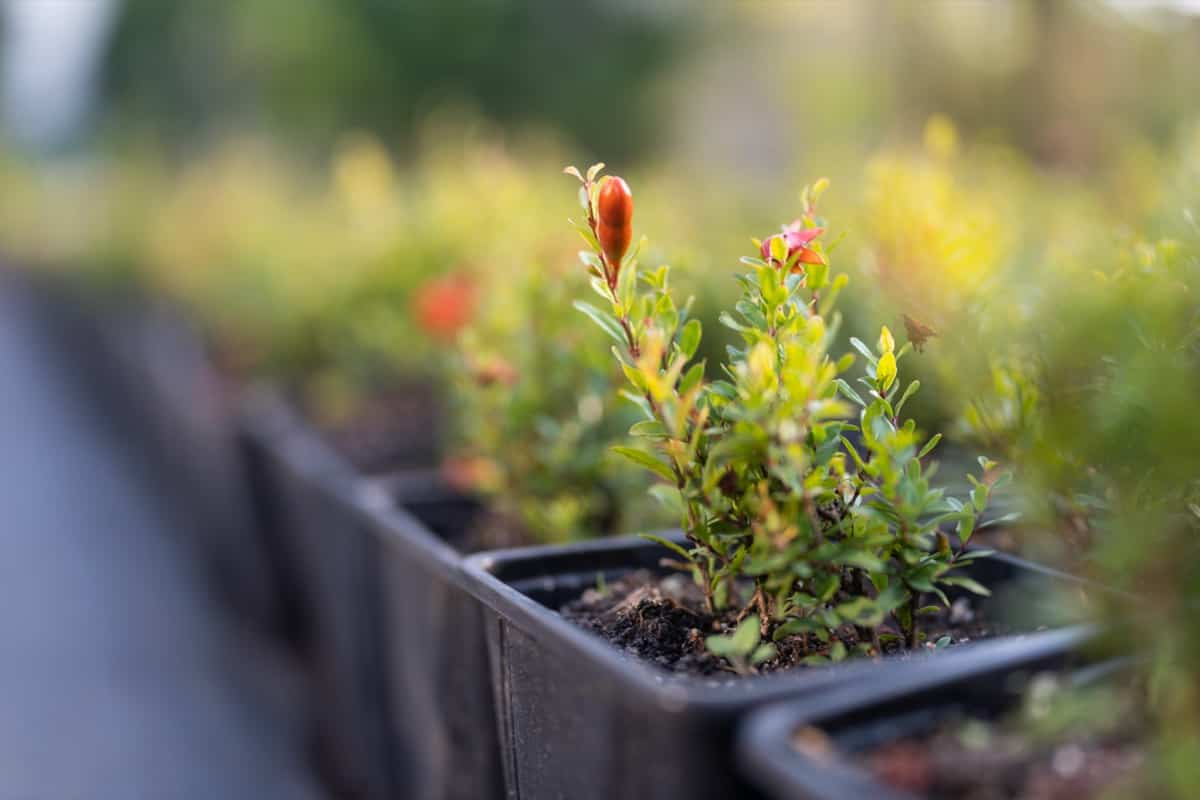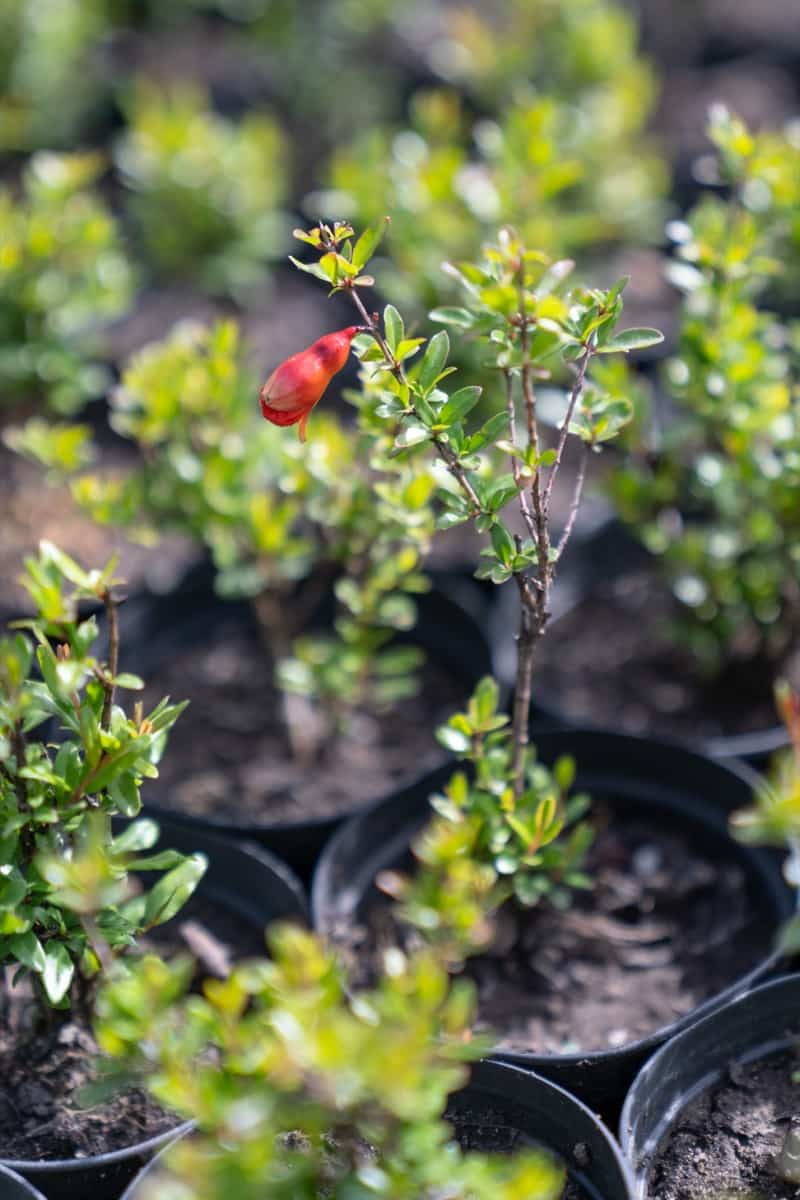Pomegranate trees are a beloved addition to any garden or patio, and when grown in pots, they require specific care to thrive. One crucial aspect of their care is fertilization. Providing the right nutrients at the right levels can ensure the health and productivity of potted pomegranate trees. In this guide, we will explore different fertilization methods, including organic, natural, and homemade options, and understand the importance of the NPK ratio and when and how to apply fertilizers.

Fertilizing Potted Pomegranate Trees
Organic Fertilizers for Pomegranate Trees in Pots: Nurturing Your Plants Naturally
Organic fertilizers offer a natural and environmentally friendly approach to nourishing potted pomegranate trees. These fertilizers are produced from natural sources such as plant materials, animal manure, and mineral deposits. They provide a slow release of nutrients, ensuring a steady supply of essential elements to your trees. Some popular organic fertilizers for pomegranate trees include compost, aged manure, seaweed extract, and bone meal.
Compost, created by decomposing organic matter, enriches the soil with a balanced range of nutrients. Aged manure, such as a cow or chicken manure, is an excellent nitrogen, phosphorus, and potassium source. Rich in trace minerals, seaweed extract stimulates growth and enhances the tree’s disease resistance. Bone meal, high in phosphorus, promotes strong root development and robust flowering.
Natural Fertilizers for Pomegranate Trees in Pots: for Environmentally-friendly Options
Several alternatives are available if you prefer natural fertilizers but want to avoid animal-based products. Natural fertilizers are made from plant-based materials and other organic sources. They provide a sustainable and eco-friendly way to nourish your potted pomegranate trees. Some popular natural fertilizers for pomegranate trees include alfalfa meal, cottonseed meal, and kelp meal.
Alfalfa meal, derived from dried alfalfa plants, enriches the soil with nitrogen, potassium, and other essential minerals. Cottonseed meal, made from crushed cottonseeds, is a slow-release fertilizer that promotes healthy growth. Kelp meal, obtained from dried and ground seaweed, provides a rich source of micronutrients, vitamins, and hormones to improve overall plant health.
In case you missed it: 10 Signs that Tell You If a Pomegranate is Ripe and to Be Picked

Homemade Fertilizers for Pomegranate Trees in Pots: DIY Solutions for Optimal Plant Health
Creating homemade fertilizers can be a rewarding and cost-effective option for potted pomegranate trees if you enjoy a hands-on approach. These DIY solutions often utilize readily available ingredients, making them convenient and customizable to your tree’s needs. One simple homemade fertilizer recipe involves mixing equal parts of compost, coffee grounds, and crushed eggshells.
The compost provides a nutrient-rich base, while coffee grounds add nitrogen and improve soil structure. Crushed eggshells are a natural calcium source, promoting healthy fruit development. Another homemade fertilizer option is banana peel tea. You can create a potassium-rich liquid fertilizer by soaking banana peels in water for a few days. This should be applied directly to the soil or as a foliar spray to enhance nutrient absorption.
NPK Ratios and Their Importance in Selecting Fertilizers for Pomegranate Trees in Pots
NPK stands for nitrogen (N), phosphorus (P), and potassium (K) – three essential nutrients that are vital for plant growth and development. Each nutrient has a specific role in the overall health of the pomegranate tree. Nitrogen promotes leaf and stem growth, phosphorus helps with root development and flowering, and potassium enhances plant vigor and fruit production.
To ensure optimal growth and fruiting, choosing a fertilizer with the right NPK ratio for pomegranate trees in pots is important. The ideal ratio for pomegranate trees is generally 2:1:1, meaning twice as much nitrogen as phosphorus and potassium. This ratio provides a balanced nutrient supply, supporting vegetative growth and fruiting.
Slow-release Fertilizers: Enhancing Nutrient Availability for Pomegranate Trees in Pots
One effective option for fertilizing pomegranate trees in pots is to use slow-release fertilizers. Slow-release fertilizers are designed to gradually release nutrients over an extended period, ensuring a steady supply of essential elements to the pomegranate tree. Slow-release fertilizers offer several advantages for potted pomegranate trees.
Firstly, they minimize the risk of nutrient leaching, as the nutrients are released slowly and are less likely to be washed away by excess watering. This helps to improve nutrient efficiency and reduce environmental impact. Secondly, slow-release fertilizers provide a more consistent nutrient supply to the pomegranate tree, avoiding sudden nutrient spikes or deficiencies. This promotes balanced growth and overall plant health.
pH Levels and Fertilizer Selection for Pomegranate Trees in Pots: For Balanced Soil Environment
Maintaining the right pH levels in the soil is essential for pomegranate trees in pots. The pH affects the intake of nutrients to the tree’s roots. Ideally, the soil pH for pomegranate trees should be slightly acidic, ranging from 5.5 to 7. When selecting fertilizers for pomegranate trees in pots, it is important to consider the pH requirements of the tree.
In case you missed it: When to Prune Pomegranate Tree: Best Time, Schedule, Season, and Techniques

Acidic fertilizers, such as those containing ammonium sulfate or sulfur-coated urea, can help lower the pH of alkaline soil. On the other hand, if the soil is already acidic, using fertilizers with alkaline components, such as potassium carbonate, can help raise the pH level and create a more balanced soil environment.
The Importance of Timing: When to Apply Fertilizer to Pomegranate Trees in Pots
Timing is crucial when applying fertilizer to pomegranate trees in pots. Applying fertilizer at the right time ensures that the nutrients are available when the tree needs them the most. For potted pomegranate trees, it is recommended to apply fertilizer in early spring, just before the active growing season begins.
This boosts nutrients for the tree’s initial growth and development. Additionally, it is advisable to apply fertilizer again in early summer, around June or July, to support the tree’s fruiting stage. This ensures that the pomegranate tree has an adequate nutrient supply during the critical period of fruit formation.
How to Apply Fertilizer to Pomegranate Trees in Pots: Techniques for Maximum Effectiveness
To apply fertilizer to pomegranate trees in pots for maximum effectiveness, follow these techniques. First, choose a balanced fertilizer with equal nitrogen, phosphorus, and potassium. Fertilizer application should be done during the spring and summer growing seasons, avoiding the dormant winter.
Start by watering the tree thoroughly, then sprinkle the recommended amount of fertilizer evenly around the tree’s base. Avoid direct contact with the trunk to prevent burning. After applying the fertilizer, water the tree again to help it absorb the nutrients. Repeat this process every four to six weeks during the growing season.
Water-soluble Fertilizers for Potted Pomegranate Trees
These fertilizers are designed to dissolve easily in water, making them ideal for providing essential nutrients to plants. Pomegranate trees grown in pots have limited access to nutrients compared to those planted in the ground, making water-soluble fertilizers even more crucial.
These fertilizers are available in various formulations, allowing gardeners to tailor the nutrient mix to the specific needs of their potted pomegranate trees. Applying water-soluble fertilizers according to the manufacturer’s instructions will help promote healthy growth and vibrant fruit production in potted pomegranate trees. Ensure to follow the appropriate dosage and frequency to avoid over-fertilization, which could harm the trees.
In case you missed it: How to Pollinate Pomegranate Flowers: Hand Pollination, Natural Pollination, and Tips

Conclusion
Fertilizing potted pomegranate trees with organic, natural, and homemade fertilizers is essential for their health and productivity. Understanding the NPK ratio and applying fertilizers at the right time and in the right manner will ensure optimal growth and fruit production for your potted pomegranate tree.
- Feed Your Flock for Less: Top 10 Tips to Save on Chicken Feed
- Ultimate Guide to Ossabaw Island Hog: Breeding, Raising, Diet, and Care
- Hatching Answers: The Top 10 Reasons Your Chickens Aren’t Laying Eggs
- Eggs and Economics: Breaking Down the Cost of Raising Backyard Chickens
- Defend Your Greens: Proven Methods to Keep Iguanas Out of Your Garden
- Ultimate Guide to Cinnamon Queen Chicken: A Comprehensive Guide for Beginners
- Ultimate Guide to California Tan Chicken: Breeding, Raising, Diet, Egg-Production and Care
- Ultimate Guide to Marsh Daisy Chicken: Breeding, Raising, Diet, and Care
- 10 Types of Chicken Farming Businesses You Can Start for Profits